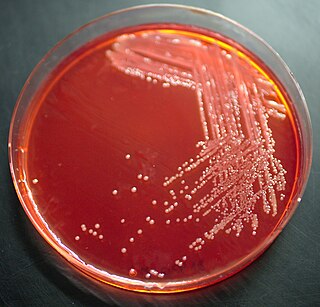
Yersinia pestis is a gram-negative, non-motile, coccobacillus bacterium, without spores that is related to both Yersinia pseudotuberculosis and Yersinia enterocolitica. It is a facultative anaerobic organism that can infect humans via the Oriental rat flea. It causes the disease plague, which caused the First plague pandemic and the Black Death, the deadliest pandemic in recorded history. Plague takes three main forms: pneumonic, septicemic, and bubonic.

Yersinia enterocolitica is a Gram-negative, bacillus-shaped bacterium, belonging to the family Yersiniaceae. It is motile at temperatures of 22–29°C (72–84°F), but becomes nonmotile at normal human body temperature. Y. enterocolitica infection causes the disease yersiniosis, which is an animal-borne disease occurring in humans, as well as in a wide array of animals such as cattle, deer, pigs, and birds. Many of these animals recover from the disease and become carriers; these are potential sources of contagion despite showing no signs of disease. The bacterium infects the host by sticking to its cells using trimeric autotransporter adhesins.
Staphylococcus massiliensis is a Gram-positive, coagulase-negative member of the bacterial genus Staphylococcus consisting of clustered cocci. Strains of this species were first isolated from a human brain abscess and were found to be most closely related to Staphylococcus piscifermentans, Staphylococcus condimenti, Staphylococcus carnosus subsp. carnosus, Staphylococcus carnosus subsp. utilis, and Staphylococcus simulans. A subsequent study found that S. massiliensis may actually be part of the human skin microbiome and may have been a contaminant of brain abscess-derived samples.
Yersinia kristensenii is a species of bacteria. It is Gram-negative and its type strain is 105. It is potentially infectious to mice. It secretes a bacteriocin that targets related species.
Yersinia intermedia is a Gram-negative species of bacteria which uses rhamnose, melibiose, and raffinose. Its type strain is strain 3953. It has been found in fish, and contains several biotypes. It is not considered of clinical relevance, being isolated from humans in a routine manner.
Yersinia aldovae is a species of bacteria that was originally described as Group X2 Yersinia enterocolitica. Its type strain is CNY 6005. Y. aldovae has been isolated from aquatic environments and soil, but it has not been associated with animal or human illnesses.
Afipia birgiae is a species in the Afipia bacterial genus. It is a gram-negative, oxidase-positive rod in the alpha-2 subgroup of the class Proteobacteria. It is motile by means of a single flagellum. Its type strain is 34632T.
Legionella massiliensis is a Gram-negative bacterium from the genus Legionella which was isolated from water from a cooling tower in Bouches du Rhone in France.
Bosea massiliensis is a bacterium from the genus of Bosea which was isolated in Marseille in France.
Bosea vestrisii is a bacterium from the genus of Bosea which was isolated from hospital water.
Holdemania massiliensis is a Gram-positive, anaerobic, non-spore-forming and non-motile bacterium from the genus Holdemania which has been isolated from human feces.
Brachybacterium is a genus of Gram positive, nonmotile bacteria. The cells are coccoid during the stationary phase, and irregular rods during the exponential phase. The genus name comes from Greek word brachy, meaning short, and Latin bacterium, meaning rods, referencing the short rods noted during the exponential phase.
Yersinia entomophaga is a species of bacteria that was originally isolated from the diseased larvae of the New Zealand grass grub, Costelytra zealandica. The type strain is MH96. It is currently being studied for biological pest control of insect pests like the porina moth, Wiseana cervinata.

Yersinia hibernica is a species of Yersinia that was originally isolated in a pig-production environment. The type strain is CFS1934. This species has previously been misidentified as Yersinia enterocolitica and Yersinia kristensenii but it may be distinguished biochemically by lack of sucrose utilization. In addition to pig related environments, Y. hibernica has also been isolated from the feces of Rattus norvegicus and Hydrochoerus hydrochaeris.
Yersinia aleksiciae is a Gram-negative bacteria that is commonly isolated from the feces of warm-blooded animals such as humans, reindeers, and pigs. The type strain is Y159.
Yersinia nurmii is a Gram-negative species of Yersinia that was originally isolated in packaged broiler meat cuts. The type strain is APN3a-c.
Yersinia pekkanenii is a Gram-negative species of Yersinia that has been isolated from water, soil, and lettuce samples. The type strain is ÅYV7.1KOH2.
Yersinia rohdei is a Gram-negative species of Yersinia that was originally isolated from the feces of humans and dogs in addition to water surfaces. The type strain is ATCC 43380. Y. rohdei strains have also been isolated from reindeer and kelp gull from the sub-Antarctica South Georgia island.
Yersinia similis is a Gram-negative bacteria species of Yersinia that resembles Yersinia pseudotuberculosis phenotypically but differs on the basis of 16S ribosomal RNA sequences. The type strain Y228 was originally isolated from a rabbit in Germany.
Weeksella massiliensis is a bacterium from the genus of Weeksella. Weeksella massiliensis has been isolated from the urine from a man with acute cystitis Weeksella massiliensis is a human pathogen.


